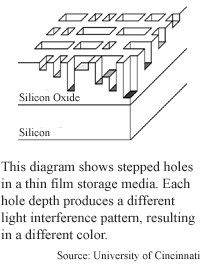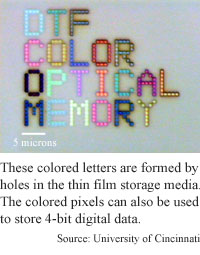
Color deepens data storage
By Kimberly Patch, Technology Research NewsComputers have always stored information using different physical states, like the opposite poles of a magnet, to represent the ones and zeros of the binary number system.
Efforts to store more information in magnetic media are focused on cramming more magnets into the same space rather than increasing the complexity of the information because magnets only have two poles.
Being able to store more than two possible meanings in one physical area, however, is another way to cram more information into a small space.
With this in mind, a team of researchers the University of Cincinnati is using the different colors of light reflected from tiny holes in a thin film of silicon dioxide to gain many different colors that can be used to encode bits. The color of the reflected light depends on the depth of the hole. Like magnetic media, each bit still has two states, but "at every location I can have multiple bits," said Andrew Steckl, a professor of solid-state microelectronics and director of the Nanoelectronics Laboratory at the University of Cincinnati.
The scheme is a write once, read many (WORM) method, meaning media using it cannot be erased and rewritten.
The researchers have produced a prototype of their thin-film media that uses 16 distinct colors, but the method is scalable to many more, said Steckl. "There is virtually no limit to the number of colors that can be produced. It is solely dependent on the detector design and the detector's capability to distinguish colors in different saturation and hue level," Steckl said.
Using the 16-color prototype, the researchers have written more than five gigabytes of information on a square inch of film, which is about double the density of today's DVD disks. In theory, this type of storage media could use more colors to harbor two terabytes per square inch, according to Steckl.
To make the storage devices, the researchers added an 800-nanometer thick silicon dioxide film to a silicon wafer. To write information onto the film, they added holes of 15 different depths using focused ion beam micromilling. Individual holes, or pixels, measured half a micron to two microns in diameter and 50 to just under 800 nanometers deep. The absence of a hole added a 16th color. The researchers controlled the depth of each hole by varying the number of gallium ions shot at the film.
Holes of a specific depth reflect white light, which is a mix of all colors, with a particular interference pattern, yielding light of a certain wavelength or color. Sixteen hole depths produce 16 different colors.
Each hole can hold four bits of information because each color represents a four-bit number. This is because it takes four binary digits to write 16 different numbers, starting with 0000 and ending with 1111. "Four bits makes all the possible parameters," of the 16 states, said Steckl.
In a similar manner, four different hole depths would hold two bits of information, because there are four binary possibilities using two binary digits: 00, 01, 10 and 11. Following this pattern, eight different parameters would hold three bits of information, 36 parameters five bits, 64 parameters six bits, 128 parameters seven bits and 256 parameters eight bits.
The researchers were able to make the holes at a speed of 310 microns per second, meaning the devices are not fast in terms of writing information.
Once written, however the color information can potentially be read faster than binary storage media. Using an array of detectors, or read heads, the amount of information read equals the transfer speed of the read device multiplied by the color bit depth, said Steckl.
The film memory devices are also sturdy. Silicon dioxide is a strong material, making it difficult to alter and potentially very long-lasting, said Steckl. "The robustness of this material makes it [a good candidate] for data storage in harsh environments such as high-temperature or radiation. It may store data [for] centuries," said Steckl. It's also potentially useful for secure applications like smartcards because it is so difficult to alter, he added.
In addition to providing archival computer storage, the tiny points of color could be used to form words or symbols, said Steckl. "A machine that is trained to optical character recognition or a human could excerpt information very quickly," through symbols or words spelled out using the colors, Steckl said.
The researchers can also increase the number of hole depths to gain more colors and therefore more bits, and decrease the size of the holes to cram more information per square inch, said Steckl. "Right now we have 16 levels, and each level is about 50 nanometers [from the next.] By improving the minimum step distance we can go from four bits per pixel to eight bits per pixel. And then by making the hole itself smaller you can also increase the density significantly," Steckl said.
The researchers next step is to make a working prototype of a drive that can read the optical film.
The memory device is a clever and potentially useful device for writing permanent information and reading it out with reflected light, said Robert Dickson, an assistant professor of chemistry at the Georgia Institute. "It provides a very nice demonstration of how, by using color, [you can] potentially write more than one bit of information per data point."
Practical applications for the thin film optical scheme could be developed in three to five years, said Steckl.
Steckl's research colleague was C.J. Chi of the University of Cincinnati. They published the research in the January 5, 2001 issue of Science. The research was funded by Department of Defense (DOD).
Timeline: 3-5 years
Funding: Government
TRN Categories: Semiconductors and Materials; Data Storage Technology
Story Type: News
Related Elements: Photo 1, Photo 2, Technical paper, "Digital Thin-Film Color Optical Memory," Applied Physics Letters, January 8, 2001.
Advertisements:
January 31, 2001
Page One
Store globally, access locally
Ordinary light could drive quantum computers
Color deepens data storage
Motor goes all the way around
Switch channels atom beams


News:
Research News Roundup
Research Watch blog
Features:
View from the High Ground Q&A
How It Works
RSS Feeds:
News
Ad links:
Buy an ad link
| Advertisements:
|
 |
Ad links: Clear History
Buy an ad link
|
TRN
Newswire and Headline Feeds for Web sites
|
© Copyright Technology Research News, LLC 2000-2006. All rights reserved.